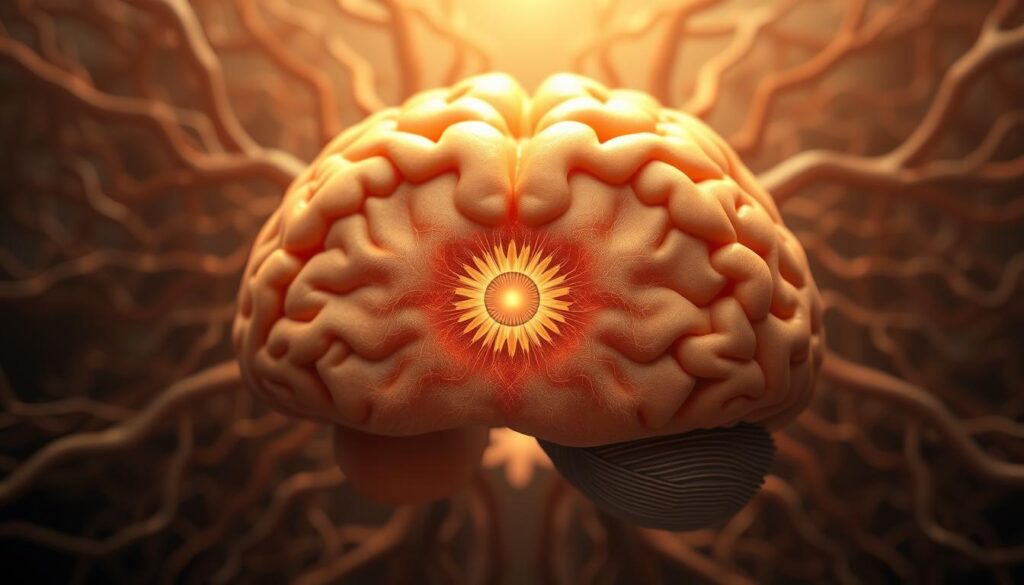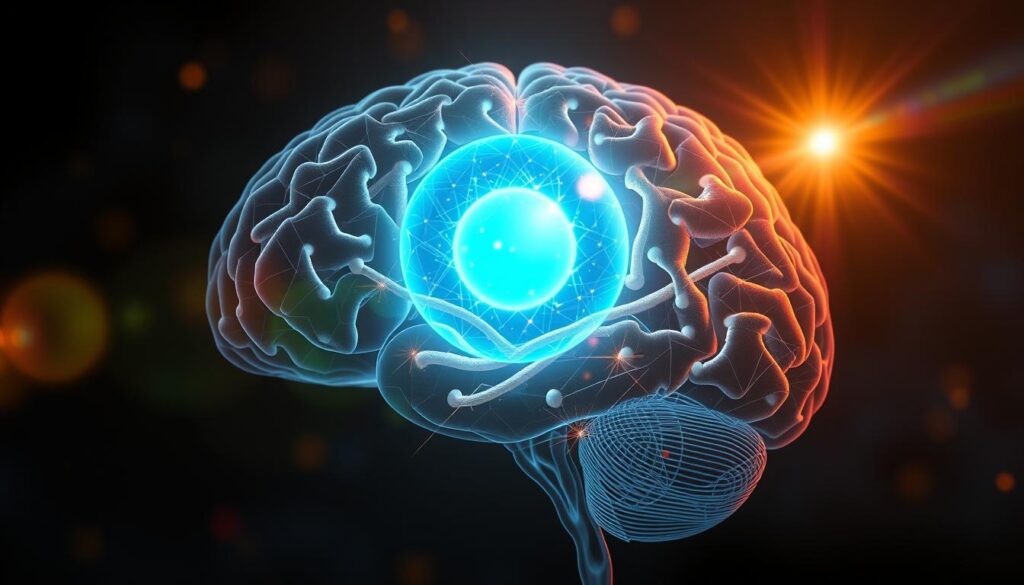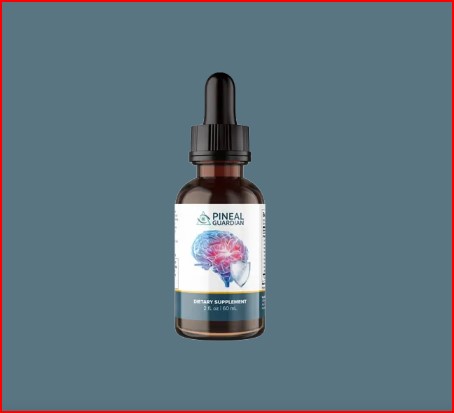Pineal Awakening 101: A Simple Guide for Beginners

Introduction to the Pineal Gland
What is the Pineal Gland?
Deep within the brain, directly between the two hemispheres, is the pineal gland, a tiny structure in the shape of a pea. Despite its small size, it holds an almost mythical reputation in both spiritual traditions and modern science. Biologically, its primary function is to produce melatonin—a hormone that regulates sleep cycles and circadian rhythms. However, its influence extends far beyond just helping you drift into dreamland.
Many traditions, especially in Eastern spirituality, regard the pineal gland as the “seat of the soul” or the “third eye,” a gateway to higher realms of consciousness. Its unique crystalline structure, containing tiny calcite microcrystals, has even led scientists to speculate that it might be sensitive to light and possibly even to electromagnetic fields. This binary scientific and mystical significance makes the pineal gland one of the most interesting organs in the human body.
When you start exploring pineal awakening, you’re diving into an intersection of biology, psychology, and spirituality. Think of it as opening a door inside your mind that has been locked for years—suddenly, colors seem more vivid, your intuition sharpens, and you begin to feel more connected to the world around you.
Historical and Spiritual Significance
The history of the pineal gland dates back thousands of years. Ancient Egyptians depicted it as the “Eye of Horus,” a powerful symbol of spiritual insight. It is frequently associated with the Ajna chakra, which is thought to be the center of wisdom and inner vision and is situated in the middle of the forehead in Buddhism and Hinduism. Philosophers like René Descartes called it the “principal seat of the soul,” hinting at its role as a bridge between the physical body and the immaterial spirit.
In sacred art, architecture, and religious symbols across cultures, the pinecone shape (resembling the pineal gland) appears repeatedly—from Mesopotamian carvings to Vatican sculptures. This consistent presence across civilizations shows a shared, almost universal recognition of its importance. Even before modern science knew its biological functions, humanity intuitively sensed that this tiny gland had a big role in human evolution—both physical and spiritual.
The Pineal Gland in Modern Science
In contemporary neuroscience, the pineal gland is primarily studied for its role in regulating sleep and seasonal biological rhythms. It receives information about light and darkness through the eyes and then influences our sleep-wake cycle. This light-sensitive behavior aligns perfectly with spiritual teachings that speak about “inner illumination” and “awakening.”
Some researchers are investigating the possibility that the pineal gland produces trace amounts of dimethyltryptamine (DMT), a naturally occurring psychedelic compound. Because DMT is linked to mystical experiences and altered states of consciousness, this concept, which is still up for debate, fascinates both scientists and spiritual seekers.
Understanding Pineal Awakening
What Does Pineal Awakening Mean?
Pineal awakening refers to activating the full potential of the pineal gland—allowing it to function not just as a biological regulator, but as a spiritual gateway. When your pineal gland awakens, it’s like someone has turned the brightness knob on your inner world. You may notice an increase in intuition, vivid dreams, heightened senses, and even moments of profound insight.
This awakening is not an overnight event. It’s a gradual process that involves physical health, mental clarity, emotional balance, and spiritual openness. Some people experience sudden breakthroughs—moments of deep clarity or visions—but for most, it’s a steady journey of inner growth.
Common Misconceptions
One of the biggest myths is that pineal awakening requires you to become a monk or spend years in a cave meditating. While disciplined practice helps, anyone can begin awakening their pineal gland with simple daily habits. Another misconception is that once your pineal gland “opens,” it stays that way forever. In reality, just like physical fitness, it requires maintenance. Neglecting your internal, emotional, and physical health can decelerate or indeed rear progress.
It’s also important to understand that pineal awakening doesn’t make you “better” than others—it’s not a badge of superiority. Rather than boosting your ego, it’s about expanding your awareness and connection.
The Connection to Higher Consciousness
The awakened pineal gland is often described as a bridge between your everyday mind and higher states of consciousness. In many traditions, this is linked to experiencing unity, divine connection, or an expanded sense of reality. The more active and healthy your pineal gland, the easier it becomes to tap into these states.
Some people describe it as tuning into a higher frequency—like switching your radio from static to a clear signal. Meditation, breathwork, and clean living all help fine-tune that “signal,” allowing you to receive insights, creative ideas, and even deep emotional healing.
Signs Your Pineal Gland is Activating
Physical Symptoms of Activation
When the pineal gland starts to “wake up,” the body often reacts in noticeable ways. Some common physical symptoms include:
- Pressure or tingling in the middle of the forehead
- Changes in sleep patterns
- Increased sensitivity to light
- Occasional headaches or dizziness
- A sudden craving for pure, natural foods
These symptoms are usually temporary and often signal that your body is adjusting to new energy flow. Think of it like the soreness you feel after starting a new workout routine—it’s your system adapting to a higher level of functioning.
Emotional and Mental Shifts
Pineal activation can also stir up deep feelings — occasionally joy and undetermined pain. Old memories may resurface, relationships may shift, and your sense of purpose might become clearer. Mentally, you might notice enhanced focus, better problem-solving skills, and a more optimistic outlook.
You may also find that material concerns lose some of their grip on you. This isn’t about becoming careless—it’s about realizing that your inner world holds far more value than temporary external circumstances.
Spiritual Insights and Intuition Boost
Perhaps the most exciting sign of pineal awakening is the sudden boost in spiritual awareness. It’s possible that you’ll start to experience synchronicity—important coincidences that look too perfect to be random. Your dreams might become more vivid, and your gut feelings more accurate. Many describe feeling a stronger connection to nature, other people, and a universal energy that seems to guide them.
Preparing for Pineal Awakening
Cleansing the Body and Mind
Preparation is crucial for a smooth awakening. Just like tuning a musical instrument, your body and mind need to be in harmony. This means adopting a cleaner diet, drinking pure water, and practicing daily mental hygiene through meditation or mindfulness. A cluttered mind is like a fogged-up window—you can’t see clearly until you wipe it clean.
Removing Environmental Blockages
One of the biggest obstacles to pineal activation is exposure to toxins—especially fluoride and heavy metals. The gland might become calcified from these substances, making it less responsive. Switching to fluoride-free toothpaste, filtering your water, and reducing processed food intake are small but powerful steps.
Setting Intentions and Mindset
Your mindset is the key that unlocks this process. Entering pineal awakening with fear or doubt can create resistance, while approaching it with curiosity and openness invites growth. Setting a clear intention—like “I awaken my inner vision for truth and love”—can align your subconscious with your spiritual goals.
Techniques for Activating the Pineal Gland

Meditation Practices
Meditation is the backbone of pineal activation. Techniques like focusing on the space between your eyebrows, visualizing light flooding your forehead, or chanting specific mantras can stimulate the gland. Over the time, even ten minutes a day can make a difference.
Breathwork and Energy Exercises
Controlled breathing exercises—such as alternate nostril breathing or the “breath of fire”—help energize the brain and increase oxygen flow, which benefits the pineal gland.
Sound and Frequency Stimulation
It is believed that certain frequencies, such as 963 Hz or 432 Hz, resonate with the pineal gland. During meditation, listening to solfeggio tones or binaural beats can help stimulate activation.
The Role of Diet in Pineal Awakening
Foods that Support Pineal Health
The pineal gland can be obstructed like a drain by certain foods. Think of your pineal gland like a delicate, ancient instrument—it needs the right kind of “fuel” to play the music of higher consciousness. Nutrient-rich, whole foods keep your brain and body clean, reducing the buildup of toxins that can calcify or block the gland.
Some excellent pineal-supportive foods include:
- Raw cacao – Packed with antioxidants and magnesium, it boosts mood and brain health.
- Chlorella and spirulina – These green superfoods detoxify heavy metals and provide essential minerals.
- Goji berries – Known for their high antioxidant levels, they support eye and brain function.
- Blueberries – Improve memory and aid in the fight against oxidative stress.
- Beets – Enhance blood flow to the brain, which benefits the pineal gland’s oxygen supply.
Eating fresh, organic produce and reducing processed food intake gives your pineal gland a clean environment to function at its best.
Foods and Substances to Avoid
If certain foods nourish the pineal gland, others can clog it like a drain. The biggest culprits are:
- Fluoride (in tap water and some toothpaste)
- Refined sugar
- Artificial sweeteners
- Highly processed foods
- Excessive caffeine and alcohol
Over time, these substances contribute to calcification—a hardening of the gland that limits its spiritual and biological functions. While avoiding them completely can be challenging, even reducing intake can yield noticeable results.
Detox Practices for Fluoride and Heavy Metals
Detoxification is essential for anyone serious about pineal awakening. Natural detox methods include:
- Drinking distilled or spring water
- Eating iodine-containing foods like seaweed to flush out fluoride.
- Taking activated charcoal to bind and expel toxins
- Using cilantro and chlorella to detox heavy metals
A clean pineal gland is like a polished mirror—capable of reflecting spiritual light with clarity.
Meditation and Visualization for Pineal Activation

Guided Meditations
For beginners, guided meditations are one of the easiest ways to start activating the pineal gland. In these sessions, a narrator walks you through visualizations and breathing techniques, allowing you to focus without worrying about what to do next. Popular guided practices involve imagining a glowing orb of light between your eyebrows or envisioning your “third eye” opening like a blossoming flower.
Visualization of Light and Energy
Visualization is powerful because the brain responds to imagined experiences as if they were real. By picturing light entering your forehead, flooding your brain with warmth and clarity, you send signals to your body that can stimulate pineal activity. This is similar to “mental rehearsal” used by athletes—only here, you’re training your spiritual senses.
Third Eye Focusing Techniques
This method involves gently closing your eyes and focusing your inner gaze on the point between your eyebrows. At first, you might only see darkness, but over time, colors, shapes, or flashes of light may appear. This indicates increased activity in the pineal gland and associated brain regions.
How Melatonin and Sleep Cycles Affect It
Melatonin, the hormone that regulates your sleep cycle which is produced by the pineal gland. Consistent, high-quality sleep ensures that the gland can perform its hormonal functions and also enter deeper states of consciousness during rest. Poor sleep, on the other hand, can disrupt melatonin production and hinder spiritual growth.
Lucid Dreaming and Astral Travel
Lucid dreaming—the ability to become aware that you’re dreaming—often increases after pineal activation. This is because the gland plays a role in dream perception and possibly in producing chemicals that facilitate altered states. Some practitioners also report experiences of astral travel—where consciousness seems to leave the physical body and explore other dimensions. While controversial in science, it is a common theme in spiritual traditions.
Techniques to Enhance Dream Awareness
Improving dream recall and awareness can help strengthen your connection with your pineal gland. Useful practices include:
- Keeping a dream journal by your bed
- Fixing a goal before sleeping (“I’ll remember my dreams tonight”)
- Practicing reality checks during the day so they carry into your dreams
Common Challenges During Pineal Awakening
Overcoming Doubt and Fear
Doubt is one of the biggest roadblocks in this journey. It’s normal to question whether anything is happening or to feel fear when strange sensations occur. Remember, the pineal gland awakening process is highly individual. Trust your experiences, but also stay grounded—balancing spiritual exploration with practical living.
Dealing with Energy Overload
When the pineal gland is activated, you may experience overwhelming surges of energy. This influx can be balanced through practices like grounding meditations, barefoot walking on grass, and spending time in nature.
Staying Grounded
Staying grounded ensures you can integrate spiritual insights into daily life. This means maintaining routines, eating well, exercising, and staying socially connected. Spiritual growth doesn’t require you to detach from the physical world—it’s about integrating higher awareness into everyday living.
Benefits of Pineal Awakening
Expanded Consciousness
Pineal awakening is associated with a profound increase in consciousness. This isn’t about just “thinking bigger”—it’s about experiencing life on a completely different level. People often describe feeling as if they can see the bigger picture of existence, sensing the interconnectedness of all things. It’s like moving from a black-and-white TV to full HD color—you suddenly notice subtleties and connections that were invisible before.
With an expanded consciousness, you may find your values shifting. Material possessions lose their grip, while compassion, kindness, and self-awareness take center stage. Decisions become more intuitive, and you begin trusting that inner guidance system more than external noise.
Deepened Spiritual Connection
A healthy pineal gland is often linked to a heightened sense of connection with the divine—or however you personally define the sacred. This could mean feeling closer to nature, experiencing profound meditative states, or having moments where you sense an infinite, loving presence guiding you.
In many spiritual traditions, this connection is described as a “return home”—a remembrance of something your soul has always known but temporarily forgotten. With continued practice, this connection can become a stable, grounding force in your life.
Greater Inner Peace
Inner peace is perhaps the most tangible benefit. Once the mind calms and your awareness sharpens, external chaos stops rattling you so easily. Stress levels drop, emotional reactivity decreases, and life begins to feel less like a constant struggle.
You start living with a quiet confidence—trusting the process, even when challenges arise. This doesn’t mean life becomes free of problems, but you develop a steady calm that allows you to handle them with grace.
Myths and Facts About the Pineal Gland
Debunking Common Myths
- Myth 1: You must take psychedelics to awaken your pineal gland.
Fact: While some use plant medicines, many achieve activation through meditation, breathwork, and diet alone. - Myth 2: Pineal awakening will make you psychic overnight.
Fact: While intuition may grow stronger, it’s a gradual process, not an instant transformation. - Myth 3: Only spiritual “masters” can achieve this.
Fact: Anyone can begin, no matter their background.
What Science Supports and What It Doesn’t
The role of the pineal gland in melatonin production and circadian rhythm regulation is well-supported by science. There is also research into its sensitivity to light and electromagnetic fields. However, scientific consensus does not yet confirm its spiritual or mystical functions.
Still, this doesn’t disprove spiritual claims—it simply means more research is needed. Many spiritual practitioners argue that direct personal experience can reveal truths that science has not yet measured.
Combining Science and Spirituality
Accepting both points of view is the most effective strategy. Recognize the pineal gland’s biological role while also exploring its potential for deeper awareness. You don’t need to pick sides—science can provide the “how,” while spirituality explores the “why.”
Advanced Practices for Continued Activation
Kundalini Energy Work
Kundalini energy is believed to rest at the base of the spine until awakened through practices like yoga, breathwork, or meditation. Once awakened, it rises through the chakras, eventually stimulating the pineal gland. This process can be intense, bringing waves of bliss, visions, or deep emotional release. Because of its potency, it’s best to learn Kundalini practices from experienced teachers.
Sacred Geometry and Pineal Meditation
Sacred geometry involves meditating on specific shapes—like the Flower of Life or Metatron’s Cube—which are believed to resonate with universal patterns of creation. Focusing on these designs can help align your mind with higher frequencies, indirectly stimulating the pineal gland.
Plant Medicines and Their Role
In some indigenous traditions, plant medicines like ayahuasca or San Pedro are used to activate the pineal gland and facilitate spiritual visions. While these can be powerful, they are not necessary for awakening and should be approached with caution, respect, and proper guidance.
How to Integrate Pineal Awakening into Daily Life
Mindfulness in Everyday Activities
You don’t need to be on a meditation cushion to nurture your pineal gland. Washing dishes, walking to work, or drinking tea can all become mindful rituals. The key is full presence—observing sights, sounds, and sensations without judgment. Even in routine activities, this mindful attention keeps the “third eye” active.
Building a Supportive Environment
Your surroundings matter. Fill your space with natural light, calming scents, plants, and uplifting sounds. Reducing exposure to digital clutter and spending more time in nature can help keep your energy balanced and your pineal gland receptive.
Journaling and Self-Reflection
Writing down your thoughts, dreams, and insights creates a record of your progress. Over time, patterns emerge that can reveal just how much your consciousness has shifted. Journaling also helps integrate spiritual insights into practical life decisions.
Safety Tips for Beginners
Avoiding Spiritual Burnout
In the excitement of awakening, it’s easy to overdo things—meditating for hours, fasting aggressively, or trying too many techniques at once. This can lead to fatigue or emotional instability. Keep in mind that going slowly is safer and more sustainable.
Seeking Guidance When Needed
Look for mentors, spiritual teachers, or communities that are there for you if you have experiences that make you feel lost or confused. Sharing your journey can provide clarity and reassurance.
Conclusion
The pineal gland may be small, but its potential for transformation is vast. Awakening it is not a one-time event—it’s a lifelong journey of self-discovery, balance, and deeper connection with the world around you. With patience, intention, and care, you can open the doors to a more expansive, peaceful, and spiritually fulfilling life.
FAQs
Q1: How long does it take to awaken the pineal gland?
It varies—some notice changes in weeks, others in months or years. Consistency matters more than speed.
Q2: Is pineal awakening dangerous?
If approached gradually and mindfully, it’s generally safe. Problems arise when people rush the process or neglect grounding practices.
Q3: Do I need special equipment or supplements?
No. While certain tools can help, meditation, diet, and lifestyle changes are enough for most people.
Q4: Can children awaken their pineal gland?
Children already have naturally active pineal glands, which often calcify with age. Their awareness can be nurtured through mindfulness and healthy living.
Q5: Is this process religious?
Not necessarily. Pineal awakening is a personal journey that can fit into any belief system—or none at all.



Post Comment